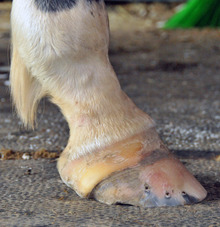At the Department of Large Animal Clinical Sciences at Copenhagen University in Denmark, researchers used six mature horses to study coronary band temperature. The horses were divided into three dietary groups.

Coronary band on horse's hoof
Excessive heat in the coronary band of a horse has been interpreted to indicate the possibility of laminitis, but recent research indicates that it is not completely accurate as a predictor.
One group was fed a high-fructan grain diet in the morning; another group was fed the same diet in the afternoon; and the last group was fed a low-carbohydrate feed. Diets were fed for a ten-day adaptation period and four trial days.
On the four trial days, the temperatures of each horse’s coronary bands were recorded in the morning and evening. Ambient air temperature and each horse’s rectal temperature were also recorded hourly. Each set of horses ate each diet for one 14-day period during the study.
The researchers found that coronary band temperatures varied quite a bit among the horses, ranging from a low of 49o F (9o C) to a high of 95o F (35o C). Temperature fluctuations generally followed the springtime ambient air temperature pattern, rising through the day and falling at night.
Also, different limbs on the same horse could have warmer or cooler coronary bands by as much as 17 degrees at the same time. None of the horses developed laminitis, and diet was found to have no influence on coronary band temperatures in this study.
However, horse owners should be vigilant for other signs that might indicate their horses have hoof problems. Laminitis is a painful disease that cripples or kills numbers of horses every year, and owners need to remember that horses in this project were exposed to only one risk factor (high-fructan meals).
Often, excessive heat has been interpreted to indicate the possibility of laminitis and checking the coronary band has become a time-honored practice. But is it completely accurate as a predictor? Most likely not, according to this recent research.
Causes of laminitis are numerous: overconsumption of grain or lush grass, sustained concussion on hard surfaces, ingestion of toxins, metabolic disturbances, general inflammation, and other factors. If an owner detects unusual heat in one or more hooves, this can be a sign of an injury or illness, though it may point to an abscess or some other problem besides laminitis. Horses that show this sign, especially if they are moving hesitantly or refusing to walk, should be evaluated by a veterinarian.
Read more about Laminitis
